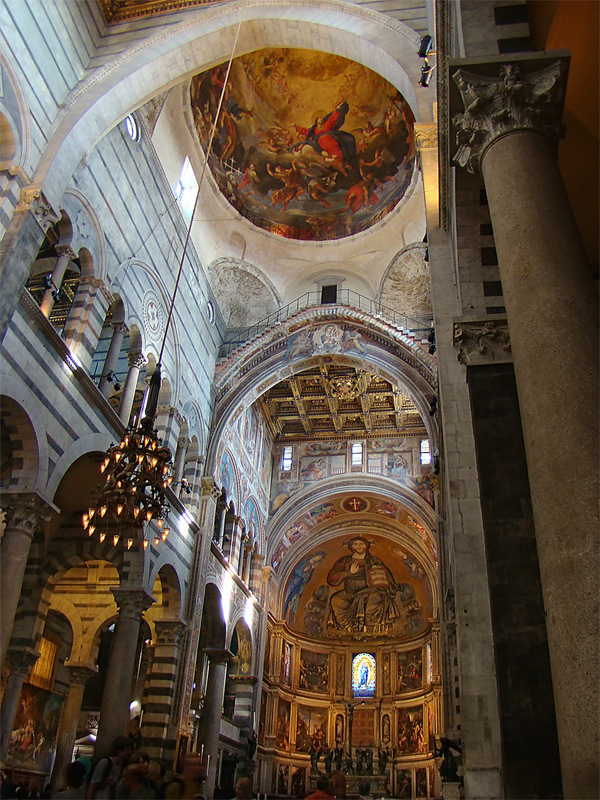Text is from Wikipedia - the free encyclopaedia,
unless otherwise stated.

The Cathedral of Santa Maria Assunta
(Saint Mary of The Assumption),
Pisa, Italy.
The Dome, depicting The Ascension of The Blessed Virgin, by Riminaldi.
Also seen is "The Lamp of Galileo" (leading him to invent the Law of
The Isochrony of The Pendulum), a Work by Vincenzo Possenti, 1586.
This File: 10 October 2005.
User: JoJan.
Source: Not known.
Author: Not known.
(Wikimedia Commons)

English: Pisa Cathedral, Italy.
Italiano: Il Duomo di Santa Maria Assunta, Pisa, Italia.
Deutsch: Der Dom Santa Maria Assunta, Pisa, Italien.
Français: La Cathédrale de Pise.
Nederlands: De dom van Pisa.
Español: El Domo de Pisa, Italia.
Photo: 8 May 2007.
Source: Own work.
Author: Stefan Lew.
(Wikimedia Commons)

Pisa Cathedral,
The Leaning Tower of Pisa,
and The Baptistry.
Photo: 18 November 2011.
Source: Own work.
Author: Clayton Tang.
(Wikimedia Commons)
The heart of the Piazza del Duomo, Pisa, Italy, is the Duomo, the Mediaeval Cathedral of the Archdiocese of Pisa, Dedicated to Santa Maria Assunta (Saint Mary of The Assumption). The Cathedral has two Aisles on either side of the Nave. The Transept consists of three Aisles. The Church is known also as a Primatial Church, the Archbishop of Pisa being a Primate since 1092.
Its construction began in 1064 by the architect Buscheto. It set the model for the distinctive Pisan Romanesque Style of architecture. The mosaics of the Interior, as well as the Pointed Arches, show a strong Byzantine influence.
The façade, of Grey Marble and White Stone, set with discs of Coloured Marble, was built by a Master Builder named Rainaldo, as indicated by an inscription above the Middle Door: Rainaldus prudens operator.
The massive Bronze Main Doors were made in the workshops of Giambologna, replacing the original doors destroyed in a fire in 1595. The original Central Door was of Bronze, made around 1180 by Bonanno Pisano, while the other two doors were probably of Wood. However, Worshippers have never used the façade doors to enter, instead entering by way of the Porta di San Ranieri (Saint Ranieri's Door), in front of The Leaning Tower, built around 1180 by Bonanno Pisano.

The Duomo, the Mediaeval Cathedral of The Archdiocese of Pisa, Italy.
Photo: 16 November 2013.
Source: Own work.
Author: Saffron Blaze.
Permission: Outside of Wikimedia Foundation projects, Attribution is to be made to:
W. Lloyd MacKenzie, via Flickr @ http://www.flickr.com/photos/saffron_blaze/
(Wikimedia Commons)
Above the doors are four rows of Open Galleries with, on top, statues of The Madonna with Child and, on the corners, The Four Evangelists.
Also in the façade, is found the tomb of Buscheto (on the Left Side) and an inscription about the Foundation of the Cathedral and the victorious battle against the Saracens.
At the East End of the Exterior, high on a Column rising from the Gable, is a modern replica of The Pisa Griffin, the largest Islamic metal sculpture known, the original of which was placed there, probably in the 11th- or 12th-Century, and is now in the Cathedral Museum.
The Interior is faced with Black and White Marble and has a Gilded Ceiling and a Frescoed Dome. It was largely redecorated after a fire in 1595, which destroyed most of the Renaissance art works.

The Mediaeval Pulpit,
by Giovanni Pisano,
in Pisa Cathedral.
This File: 21 October 2005.
User: JoJan.
Source: Not known.
Author: Not known.
(Wikimedia Commons)
Galileo is believed to have formulated his Theory about the movement of a pendulum by watching the swinging of the Incense Lamp (not the present one) hanging from the Ceiling of the Nave. That Lamp, smaller and simpler than the present one, is now kept in the Camposanto, in the Aulla Chapel.
The Granite Corinthian Columns, between the Nave and the Aisle, came originally from the mosque of Palermo, captured by the Pisans in 1063.
The Coffered Ceiling of the Nave was replaced after the fire of 1595. The present Gold-Decorated Ceiling carries The Coat-of-Arms of The Medici.

English: The Apse,
Santa Maria Assunta Cathedral, Pisa, Tuscany, Italy. The Apse.
Français: Cathédrale Santa Maria Assunta, Pise, Toscane, Italie. L'abside.
Photo: 30 September 2007.
Source: Own work.
Author: Tango7174.
(Wikimedia Commons)
The present-day Pulpit is a reconstruction of the original. It does not lie in its original position, which was nearer The High Altar, and the Columns and Panels are not original. The original Stairs (perhaps of Marble) were lost.
The Upper Part has nine narrative Panels showing scenes from The New Testament, carved in White Marble with a Chiaroscuro effect and separated by: Figures of Prophets; The Annunciation; The Massacre of The Innocents; The Nativity; Adoration of The Magi; The Flight into Egypt; The Crucifixion; and two Panels of The Last Judgement.

The Coffered Ceiling,
containing the Coat-of-Arms of The Medici Family,
Pisa Cathedral, Italy.
This File: 21 October 2005.
User: JoJan.
Source: Not known.
Author: Not known.
(Wikimedia Commons)

The Interior of Pisa Cathedral, Italy.
Photo: 8 June 2006.
Source: From en.wikipedia.
Author: aLii.
(Wikimedia Commons)
Some Relics brought back during The Crusades can also be found in the Cathedral. Alleged remains of three Saints (Abibo, Gamaliel, and Nicodemus), and a Vase that is said to be one of the Jars of Cana.
The building, as have several in Pisa, has tilted slightly since its construction, though not nearly to the extent of the nearby Leaning Tower of Pisa.

No comments:
Post a Comment